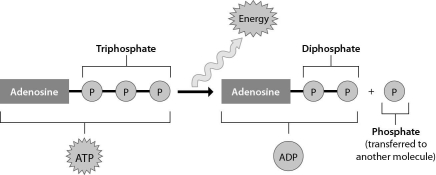A) The solution in the beaker is hypertonic relative to the solution in the balloon.
B) The solution in the balloon is isotonic; the solution in the beaker is hypertonic.
C) When placed in the beaker, the balloon will lose water by osmosis.
D) The solution in the balloon is hypertonic relative to the solution in the beaker.
Correct Answer

verified
D
Correct Answer
verified
Multiple Choice
What is energy?
A) the capacity to cause movement
B) the capacity to cause change
C) a measure of calories
D) a measure of disorder
Correct Answer

verified
Correct Answer
verified
Multiple Choice
If placed in tap water,an animal cell will undergo lysis,whereas a plant cell will not.What accounts for this difference?
A) expulsion of water by the plant cell's central vacuole
B) the relative impermeability of the plant cell membrane to water
C) the relative impermeability of the plant cell wall to water
D) the relative inelasticity and strength of the plant cell wall
Correct Answer

verified
Correct Answer
verified
Multiple Choice
Anything that prevents ATP formation will most likely ______.
A) result in cell death
B) force the cell to rely on lipids for energy
C) force the cell to rely on ADP for energy
D) have no effect on the cell
Correct Answer

verified
Correct Answer
verified
Multiple Choice
Diffusion ______.
A) is the result of the potential energy of atoms
B) requires an input of cellular energy
C) occurs when particles spread from areas where they are less concentrated to areas where they are more concentrated
D) proceeds until equilibrium is reached
Correct Answer

verified
Correct Answer
verified
Multiple Choice
The sum total of all the chemical reactions that occur in organisms is called ______.
A) summation
B) cellular synthesis
C) replication
D) metabolism
Correct Answer

verified
Correct Answer
verified
Multiple Choice
Enzymes increase the rate of a reaction by ______.
A) increasing the temperature of the substrates
B) contributing electrons to the reaction
C) decreasing activation energy
D) changing the pH of the substrates
Correct Answer

verified
Correct Answer
verified
Multiple Choice
When two solutions that differ in solute concentration are placed on either side of a selectively permeable membrane,and osmosis is allowed to take place,the water will ______.
A) exhibit a net movement to the side with lower water concentration
B) exhibit a net movement to the side with higher water concentration
C) exhibit a net movement to the side with lower solute concentration
D) exhibit an equal movement in both directions across the membrane
Correct Answer

verified
Correct Answer
verified
Multiple Choice
When a person cries,tears are exported from cells through the process of
A) facilitated diffusion.
B) active transport.
C) endocytosis.
D) exocytosis.
Correct Answer

verified
C
Correct Answer
verified
Multiple Choice
Energy is transferred from ATP to other molecules by transferring a(n) ______.
A) adenosine
B) heat unit
C) photon
D) phosphate group
Correct Answer

verified
Correct Answer
verified
Multiple Choice
Which of the following is a measure of randomness in a system?
A) entropy
B) kinetic energy
C) potential energy
D) chemical energy
Correct Answer

verified
Correct Answer
verified
Multiple Choice
Which one of the following is most similar to the mechanism of an enzyme inhibitor?
A) keeping someone from parking by parking in their designated spot
B) driving the wrong way on a one-way street
C) forgetting to put a cap back on a pen
D) changing the tires on a car
Correct Answer

verified
Correct Answer
verified
Multiple Choice
You are riding on your bike and stop pedaling,coasting along the road.Eventually,your bike slows down and stops.What happened to the energy of your motion when your bike stopped?
A) It was returned to the bicycle.
B) It was converted back to chemical energy.
C) It was released as heat.
D) It was used to chemically break down the tires.
Correct Answer

verified
Correct Answer
verified
Multiple Choice
Ten kilocalories are equivalent to ______ calories.
A) 1,000
B) 10,000
C) 0.1
D) 100
Correct Answer

verified
B
Correct Answer
verified
Multiple Choice
The figure below shows that ______. 
A) ADP can perform cellular work when it binds to an additional phosphate group
B) ATP can perform cellular work when it releases a phosphate group
C) ATP can be converted to ADP by adding a phosphate group
D) energy is released from ATP during the process of cellular respiration
Correct Answer

verified
Correct Answer
verified
Multiple Choice
Osmosis can be defined as ______.
A) the diffusion of water
B) the diffusion of nonpolar molecules
C) active transport
D) the diffusion of a solute
Correct Answer

verified
Correct Answer
verified
Multiple Choice
Usually,enzymes are ______.
A) fats
B) steroids
C) chemical reactions
D) proteins
Correct Answer

verified
Correct Answer
verified
Multiple Choice
An enzyme's function is dependent on its ______.
A) pH
B) temperature
C) shape
D) size
Correct Answer

verified
Correct Answer
verified
Multiple Choice
The principle that energy cannot be created or destroyed is known as ______.
A) interconversion
B) conservation of energy
C) conservation of heat
D) entropy
Correct Answer

verified
Correct Answer
verified
Multiple Choice
You have a 2-kg bottle of liquid water at 0°C.About how many Calories are needed to heat up the water to 100°C?
A) 100 Calories
B) 200 Calories
C) 2,000 Calories
D) 10,000 Calories
Correct Answer

verified
Correct Answer
verified
Showing 1 - 20 of 47
Related Exams